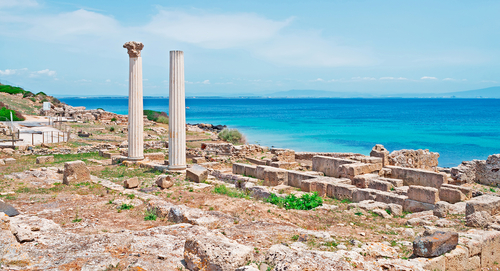Tharros and Oristano
Oristano is situated on the west coast perfectly balanced in the centre of Sardinia. It has been the capital of the Giudicato di Arborea, a sort of independent kingdom, unique case in many centuries of Sardinia’s colonisation. The historic centre is little and very well mainteined since medieval epoque. Marshes and ponds full of fish, like Cabras and Santa Giusta (the ancient Othoca) caracterize its environment and food.
Tharros is a phoenician port of VIII centurt b.C. Situated in a strategic position repaired from all kinds of wind because of being a peninsula. Tharros was very important for the traffic between East and West Mediterranean areas. Many Egyptian scarabs were found in Tharros and that mistery is more interesting knowing that it could be the Tartessos mentioned in the Bible that is currently sought in Spain without results.
San Giovanni di Sinis is a tiny fishing village right in the south of the Sinis Peninsula, Its main sight is its homonymous church, which was originally built in the 6th century using blocks of sandstone from Tharros. In the 11th century, it was transformed from a cruciform into a more conventional longitudinal layout and various extensions were added and it is this form that has remained to the present day. The church is wonderfully understated and unpretentious both outside and in, but still manages to be a fascinating place to look round.
The Cathedral of Santa Giusta is one of the region’s most prized sights and is considered one of the best examples of Romanesque architecture in all of Sardinia. It certainly looks very impressive, standing proudly at the entrance to the village and magnificent against its humble backdrop. The Cathedral was built in the 12th century and has largely been conserved in its original form. Inside, the main focus is on the crypt, which houses the relics of Saints Giusta, Justina and Enedina.
San Salvatore Church
Most famous internationally for having being used as the set of several ‘spaghetti westerns’ during the 1960s, the tiny village of San Salvatore is free of occupants save for the first weekend in September when the Corsa degli Scalzi sees it teaming with people. Local young men run barefoot (ouch!) along the stony paths between Cabras and Tharros carrying the statue of the Holy Saviour. Apart from its fascinating little empty houses (known locally as cumbessias) the main attraction in San Salvatore is its 17th century church with its underground hypogeum. This was originally a nuragic pagan chapel, now thought to be linked to the cult of water. In the Roman era it was converted into a church, and you can still see some evidence of this now in the form of some remaining, albeit faded, frescoes on the walls. An eerie but captivating experience.

